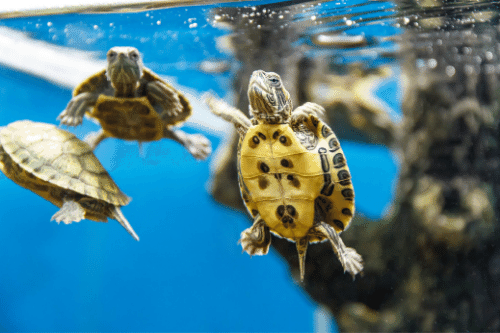Can Red Eared Slider Turtles Live In The Wild?
Have you ever seen a Red Eared Slider turtle swimming in a pond? These turtles are some of the most popular pet turtles in the world, but can they live in the wild? In this article, we’ll explore the habitat and living conditions of Red Eared Slider turtles and determine if they can live in the wild or if they’re better off in captivity.

Can Red Eared Slider Turtles Live in the Wild?
Red-eared slider turtles are popular pets, but do they also live in the wild? The answer is yes, but only in certain parts of the world. Red-eared sliders are native to the United States and can be found in the wild in many states, including Alabama, Arkansas, Florida, Georgia, Louisiana, and Mississippi. They are also commonly found in other parts of the world, including Australia, China, Japan, and some parts of Europe.
Natural Habitat of Red Eared Slider Turtles
Red-eared slider turtles are aquatic in nature and prefer habitats with slow-moving water, such as ponds, lakes, rivers, and marshes. They are often found in shallow, muddy areas with plenty of vegetation to hide in and feed off of. They prefer to basking in areas with rock or logs and can spend long periods of time in the sun.
Diet and Predators of Red Eared Slider Turtles
The natural diet of red-eared slider turtles consists of aquatic plants, snails, insects, and fish. In the wild, they can also feed on carrion, which is decaying organic matter. They are also known to eat small turtles and will occasionally consume other animals that they encounter.
Red-eared slider turtles have many natural predators, including birds, snakes, fish, and other animals. They are also vulnerable to human predators, such as poachers who collect them for the pet trade.
Behavior and Lifespan of Red Eared Slider Turtles
Red-eared slider turtles are mostly active during the day and bask in the sun for long periods of time. They are also known to be territorial and will sometimes fight with each other for prime basking spots. They are also known to migrate in the winter in order to survive.
The lifespan of red-eared slider turtles in the wild is hard to determine, as they can live for up to 30 years in captivity. In the wild, their lifespan is likely shorter due to predation and environmental factors.
Reproduction of Red Eared Slider Turtles
Red-eared slider turtles reach sexual maturity at 3-5 years of age. The female will lay her eggs in a nest that she has dug in the sand or mud. The eggs will then hatch after 2-3 months and the young turtles will burrow out of the nest and make their way to the water.
Threats to Red Eared Slider Turtles
Red-eared slider turtles face a variety of threats in the wild, including habitat destruction, pollution, and poaching for the pet trade. They are also vulnerable to predation from other animals and humans.
Conservation of Red Eared Slider Turtles
Red-eared slider turtles are listed as Least Concern by the IUCN Red List, but they are still vulnerable to predation and habitat destruction. Conservation efforts are underway to protect their habitats and to educate the public about the importance of protecting these animals.
Adaptability of Red Eared Slider Turtles
Red-eared slider turtles are highly adaptable and can survive in a variety of environments. They are also known to be very hardy and can survive in conditions that would be considered sub-optimal for other species.
Pet Red Eared Slider Turtles
Red-eared slider turtles are popular pets due to their hardy nature and long lifespan. They require a large tank with a basking area and a filtration system. They also require a diet of plant matter and animal proteins.
Conclusion
Red-eared slider turtles are native to the United States and can be found in the wild in many states. They prefer habitats with slow-moving water and are mostly active during the day. They have a varied diet and many natural predators, as well as human predators. In the wild, their lifespan is likely shorter due to predation and environmental factors. Red-eared slider turtles face a variety of threats in the wild and conservation efforts are underway to protect their habitats. They are highly adaptable and can survive in a variety of environments. Red-eared slider turtles are also popular pets due to their hardy nature and long lifespan.
Frequently Asked Questions
Can Red Eared Slider Turtles Live in the Wild?
Answer: Yes, red eared slider turtles can live in the wild. These turtles are native to the United States, and can be found in a wide range of habitats. They are commonly found in slow-moving, shallow waters with plenty of aquatic plants and access to basking spots.
In the wild, these turtles thrive in ponds, lakes, marshes, and slow-moving streams. They have a wide range of diets, including fish, crustaceans, frogs, plants, and carrion. They are also quite resilient, and can withstand a wide range of temperatures.
What Are the Requirements for Red Eared Slider Turtles to Survive in the Wild?
Answer: Red eared slider turtles need a specific environment in order to survive in the wild. They need a habitat with plenty of aquatic plants, as well as access to a basking spot. This basking spot should be within easy reach of the water, and should provide the turtle with a place to warm itself in the sun.
In addition, these turtles need a steady source of food, including fish, crustaceans, frogs, plants, and carrion. The water they inhabit should be relatively clean and clear, and the temperature should stay in the range that these turtles are accustomed to.
What Other Types of Turtles Can Live in the Wild?
Answer: There are a variety of other types of turtles that can live in the wild. These include painted turtles, snapping turtles, and soft-shelled turtles. Painted turtles are native to North America and can be found in a variety of habitats, including ponds, lakes, rivers, and marshes. Snapping turtles are found in North America and parts of South America, and they prefer slow-moving bodies of water. Soft-shelled turtles are found in North America, Asia, and Africa, and they prefer slow-moving rivers and lakes.
Each of these turtles has its own specific requirements for survival in the wild. They all require a habitat with plenty of aquatic plants and access to a basking spot. In addition, they all need a steady source of food, and the water they inhabit should be relatively clean and clear.
What Are the Benefits of Red Eared Slider Turtles Living in the Wild?
Answer: Red eared slider turtles offer a variety of benefits to the environment when they live in the wild. These turtles can help control insect populations, as they feed on a variety of aquatic insects. They can also help to keep aquatic plants in balance, as they feed on a variety of aquatic plants.
In addition, these turtles can play an important role in maintaining water quality. They filter out large particles and other pollutants, which can help to keep the water clean. Finally, they can provide a valuable source of food for other species of animals, such as birds, fish, and other amphibians.
What Should You Do if You Find a Red Eared Slider Turtle in the Wild?
Answer: If you find a red eared slider turtle in the wild, it is important to leave it alone. These turtles are wild animals, and can be easily stressed by human interaction. If you are worried about the turtle’s safety, you can create a makeshift habitat for it nearby. This should include access to a basking spot, as well as plenty of aquatic plants.
It is also important to leave the turtle’s food source untouched. Red eared slider turtles rely on a variety of food sources, including fish, crustaceans, frogs, plants, and carrion. By leaving the food source alone, you can help ensure that the turtle is able to find enough food to survive.

Was this wild turtle once a pet?
Red-eared slider turtles are an incredibly hardy species of turtle that are capable of living in a variety of habitats in the wild, from swamps and ponds to riverbanks and lakes. With their ability to adapt to different environments, red-eared slider turtles can survive and thrive in a wide range of habitats. With the right care and attention, these turtles can be a great addition to any wild environment.

